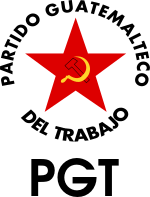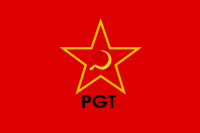Guatemalan Party of Labour
|
Guatemalan Party of Labour
Partido Guatemalteco del Trabajo |
|
|---|---|
 |
|
| Leader | Ricardo Rosales |
| Founder | José Manuel Fortuny |
| Founded | 1949 |
| Dissolved | 1998 |
| Preceded by | Revolutionary Action Party (Guatemalan Democratic Vanguard wing) |
| Succeeded by | Guatemalan National Revolutionary Unity |
| Military wing | Rebel Armed Forces (1960–1968) |
| Ideology |
Marxism–Leninism Communism |
| National affiliation | Guatemalan National Revolutionary Unity |
| Party flag | |
 |
|
The Guatemalan Party of Labour (Partido Guatemalteco del Trabajo) was a communist party in Guatemala. It existed from 1949 to 1998. It gained prominence during the government of Col. Jacobo Arbenz. It was one of the main forces of opposition to the various regimes that followed Arbenz's overthrow and became a constituent of the URNG guerrilla coalition during the later phase of the country's Civil War.
The party, then under the name Communist Party of Guatemala (Partido Comunista de Guatemala) held its constituent first congress on September 28, 1949. It was founded by the Guatemalan Democratic Vanguard, which had functioned as a fraction within the ruling Revolutionary Action Party for two years. José Manuel Fortuny had been the leader of VDG, and now became general secretary of PCG. At the time of the congress of the party, its membership stood at 43.
An earlier Communist Party of Guatemala had been founded in 1922, but was suppressed in 1932.
In June 1950 PCG started publishing a weekly newspaper, Octubre, which was distributed amongst workers, peasants and intellectuals throughout the country.
In the summer of 1950 a section of the party, led by trade union leader Víctor Manuel Gutiérrez, broke away and formed a separate party, the Guatemalan Revolutionary Workers Party (PROG). PROG made its first public appearance on July 1. The split had been provoked by differences of opinions concerning the social composition of the Central Committee of the party.
On February 2, 1952 PROG was dissolved and its members returned to PCG. The 2nd congress of PCG, held the same year, elected Gutiérrez as a Central Committee member. The congress also decided to adopt the name PGT, a move which was intended to facilitate legalization of the party. A 1945 legislation banned "international organizations" from working in Guatemala, a legislation used to maintain the illegality of any communist organization. By changing the name to PGT the party wanted to state that it was an independent and national party. At the same time, communists came to use the similar names abroad. One prominent example is the Swiss Party of Labour.
...
Wikipedia
